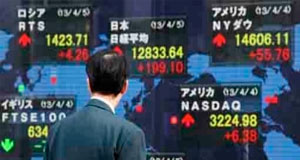 With 10 days until the end of the first quarter of 2016, some interesting capital market patterns are emerging; US markets in the green for 2016 (as most developed indices are), USD falling, JPY rising, CNY strengthening and AUD having its best start to a year since 2011.
With 10 days until the end of the first quarter of 2016, some interesting capital market patterns are emerging; US markets in the green for 2016 (as most developed indices are), USD falling, JPY rising, CNY strengthening and AUD having its best start to a year since 2011.
China has ‘reinvigorated’ its margin lending markets. Policymakers in China have decided to relax the controls put on margin lending after the collapse in Chinese markets last year. Margin loans will be offered on terms of seven to 182 days and rates will be as low as 3%. Shenzhen small caps had their best week on record last week on this rumour and volumes returned to pre-control levels. The correlation between margin lending and Chinese equities is highly correlated – this will be a positive.
The third largest intraday appreciation fix in the CNY last Friday sent the offshore CNH on a trip to the moon and raised plenty of eyebrows. Although this may have reduced expectations of a short term devaluation in the CNY, it does increase expectations that the People’s Bank of China will continue to ‘over-tweak’ the currency despite saying it won’t.
AUD hit 76.8 cents, and the question is how far up it can go? The Fed has added to our ‘perfect storm’ scenario for the AUD. The overly dovish dot plots, the downgrade to US GDP expectations and ‘transient’ inflation expectations means the hawkish pricing in the USD will likely unwind further. This will drive the aaa-credit rated, 250 plus basis point bond to expose the aud higher still. Note: nothing in currencies is linear, therefore AUD weakness may be an opportunity to go long over the coming three months.
ASX is looking to another test of 5200 point mark. SPI futures are suggesting a 0.6% increase on the open, the iron ore price is a cyclical sector positive adding 2.5% on Friday and is holding above US$50 a tonne, crude, however, lost 1.9% conflicting the leads.
We continue to ask whether there is reason for the ASX to breakout and leg higher? We cannot see it currently – maybe it’s the China leverage news or the fact that the Fed is unlikely to raise rates anytime soon but in the main we see sideways trading.
The JPY is hammering the Nikkei (NKY). The USD/JPY is at its lowest level since October 2014 thanks to the Bank of Japan’s call on rates and the Fed’s dovish view of the world.
All that work from Kuroda and co have gone in the blink of an eye. The question is how much will the JPY hurt the economic turnaround Abe has been pushing for over the past four years? If the Nikkei and the trade balance are any gauges, both are showing signs of strain already.
The Asian equity revival is a positive; it has allowed funds to flow back into the risky parts of the market. However, what I am also noticing is fund flows have begun to slow in the past week, suggesting the next leg is also being questioned by capital flows.












